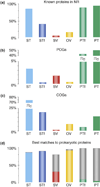New dimensions of the virus world discovered through metagenomics
- PMID: 19942437
- PMCID: PMC3293453
- DOI: 10.1016/j.tim.2009.11.003
New dimensions of the virus world discovered through metagenomics
Abstract
Metagenomic analysis of viruses suggests novel patterns of evolution, changes the existing ideas of the composition of the virus world and reveals novel groups of viruses and virus-like agents. The gene composition of the marine DNA virome is dramatically different from that of known bacteriophages. The virome is dominated by rare genes, many of which might be contained within virus-like entities such as gene transfer agents. Analysis of marine metagenomes thought to consist mostly of bacterial genes revealed a variety of sequences homologous to conserved genes of eukaryotic nucleocytoplasmic large DNA viruses, resulting in the discovery of diverse members of previously undersampled groups and suggesting the existence of new classes of virus-like agents. Unexpectedly, metagenomics of marine RNA viruses showed that representatives of only one superfamily of eukaryotic viruses, the picorna-like viruses, dominate the RNA virome.
Figures




References
-
- Bergh O, et al. High abundance of viruses found in aquatic environments. Nature. 1989;340:467–468. - PubMed
-
- Suttle CA. Viruses in the sea. Nature. 2005;437:356–361. - PubMed
-
- Fuhrman JA. Marine viruses and their biogeochemical and ecological effects. Nature. 1999;399:541–548. - PubMed
-
- Suttle CA. Marine viruses – major players in the global ecosystem. Nat. Rev. Microbiol. 2007;5:801–812. - PubMed
-
- Haaber J, Middelboe M. Viral lysis of Phaeocystis pouchetii: implications for algal population dynamics and heterotrophic C, N and P cycling. ISME J. 2009;3:430–441. - PubMed
MeSH terms
Substances
Grants and funding
LinkOut - more resources
Full Text Sources

